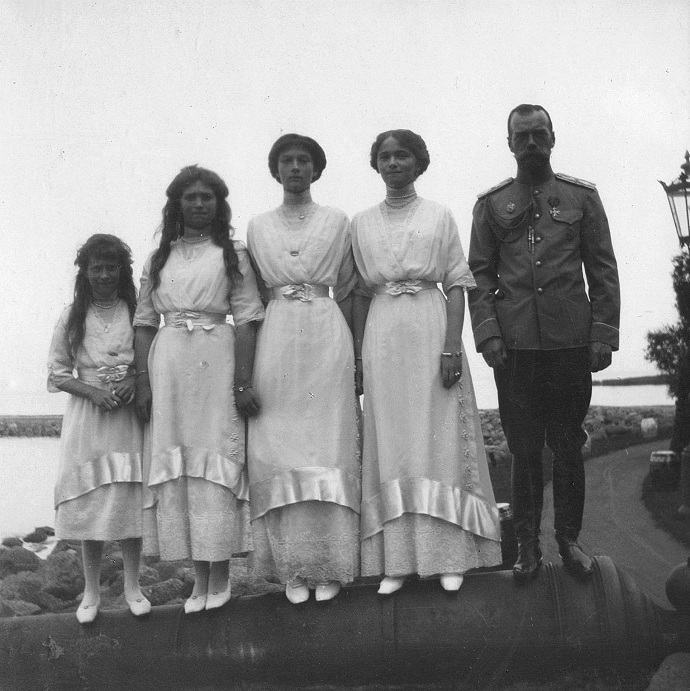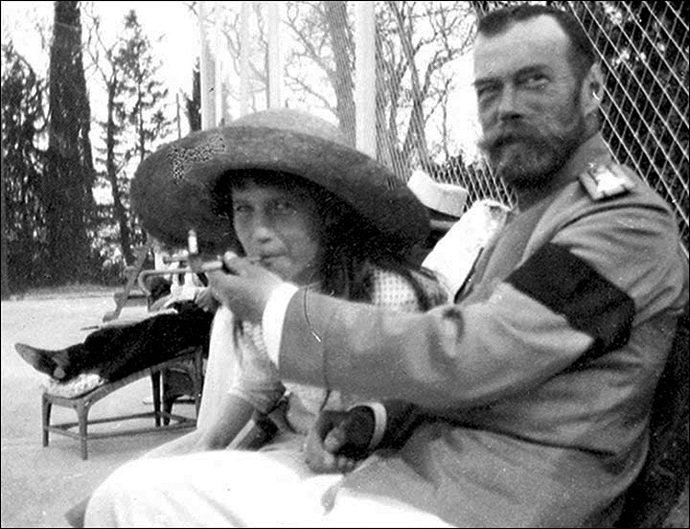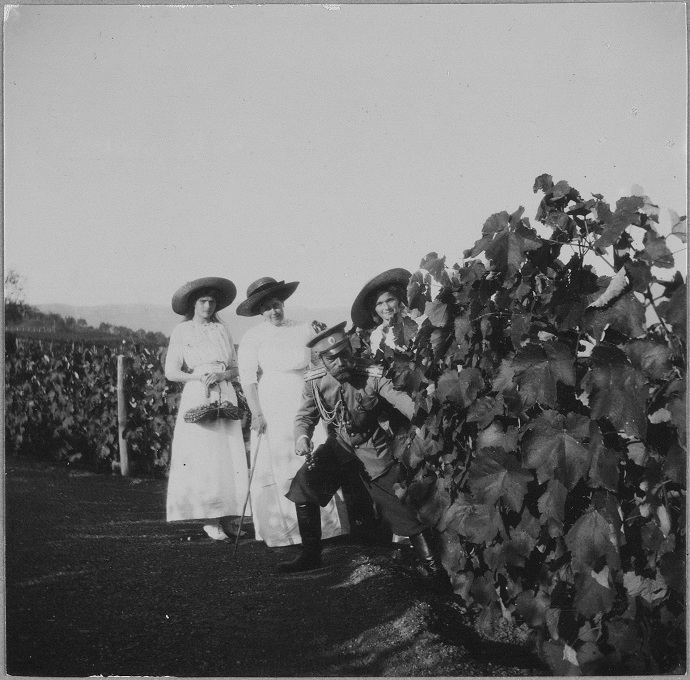By Helen Rappaport
What more is there possibly to know, you may ask, about the Romanov sisters—beyond the familiar image of four pretty girls in white dresses and big picture hats? It’s a perennial question, and one to which the common response is “not a lot.” They died young, they were innocent, lived protected lives that had left them unworldly; they had seen very little of the world beyond the palace gates and had even less experience of the people in it. Their lives were lost to history, and to us, and perhaps they would have little in them of interest.

The Romanov sisters with their father, Tsar Nicholas II, standing on a cannon
Ever since their horrific and brutal murder in July 1918, the Romanov sisters have been perceived as beautiful and tragic, certainly, but in historic terms little more than the pretty set dressing to the much more dramatic story of their parents—Nicholas and Alexandra—and their tragic hemophiliac brother. Their story is part of a huge nostalgic fantasy about the Romanovs that has endured for the last century or more and is still growing—if not intensifying—in the current resurgence of interest in old Imperial Russia, Orthodoxy, and a nationhood linked to the tsars. Much of the story of Russia’s last imperial family has become the stuff of legend, peppered with a lot of wishful thinking, and as the years pass it becomes harder and harder to separate the real Romanov sisters—Olga, Tatiana, Maria, and Anastasia—from the accumulating hagiography that now threatens to drown them in a tide of saccharine sentiment.
I, too, had succumbed to the seductive enigma surrounding them; I was haunted by the Romanov sisters when I first walked the city of Ekaterinburg in 2007, whilst researching my book The Last Days of the Romanovs (2008), about the last two weeks in the family’s lives. Walking the city, going out to the Koptyaki forest where their bodies were dumped, seeking out the places connected with the Romanov story, the girls were constantly in my head. I am a mother of daughters myself and I couldn’t help thinking of another group of sisters—Anton Chekhov’s famous literary trio, Three Sisters, the subject of his 1900 play. The plight of the Romanov sisters trapped, as prisoners, in the Ipatiev House in Ekaterinburg—like Chekhov’s three sisters stuck in a provincial town and longing escape to a better life in Moscow—captured my imagination and stayed with me through the writing of that book. I wanted to tell their stories, to give them back their identities as four very different and fascinating young women who deserve to be known and understood far better than they have been till now.

Tsar Nicholas II and Anastasia smoking
But so little had been written about them, aside from passing comments in a handful of contemporary memoirs and things said about them in family letters and diaries. What little there was seemed fragmentary and incomplete; the majority of the girls’ own letters and diaries had not been cited or translated. Yet my initial worry that I would not find enough material soon evaporated, for once I started searching—and I cast my net far and wide and looked in all kinds of unexpected places— I realized that I would have plenty to say. Indeed, by the end of my first draft it was clear that the book was too long, and I would have to cut several thousand words. The fans would love all that detail, I knew, but I had to think of the general reader.
So what did my research reveal? Well first and foremost, although there was a clampdown in the Russian press on all discussion of the Imperial Family, their private life and their movements—largely for security reasons—the foreign press was full of speculation about the lives of the four Romanov grand duchesses, was endlessly inquisitive about the lives they led, and hungry for insider information on them. As the girls grew older, inevitable speculation mounted about whom they might eventually marry, and all kinds of dynastic pairings were suggested. But all talk of marriage, particularly for Olga the eldest, evaporated when war broke out in 1914. She and her second sister, Tatiana, immediately trained as Red Cross nurses with their mother, while their younger siblings Maria and Anastasia had to content themselves with hospital visiting, which they did with great dedication. The war years revealed a different, sober, and suddenly grown-up side to the girls.
War, by the strangest of ironies, opened up a new world that the Romanov sisters had seen little of till then, by bringing them into contact with the wounded, by exposing them to real human suffering and allowing them to hear their stories. All four girls constantly longed to know more about “the outside life”—the world that their obsessive mother would not allow them to see for fear of its pernicious and immoral influences. Attendance at Russian court functions and the occasional ball was a rare treat, as too were trips to the opera and ballet in St. Petersburg with their father. In general the four sisters lived a quiet family life at home at the Alexander Palace at Tsarskoe Selo, where the family had closed ranks to protect Alexey from harm. Their summers were spent sailing on the Imperial yacht the Shtandart round the Finnish skerries, or at the Lower Dacha at Peterhof by the Gulf of Finland, or at their beloved white palace in Livadia, Crimea.
The world inhabited by the four sisters was a strange one, largely of adults—a close-knit entourage of a few hand-picked ladies who served their mother Alexandra, officers of the Shtandart and of the Cossack Escort that accompanied the family wherever they went and of course the occasional presence of the family’s wise guru Rasputin—a man whom the girls came to trust and even revere.

Olga and Tatiana picking grapes with Tsar Nicholas II
For the most part, life for the four Romanov sisters was circumscribed by the huge and very real threat of assassination and revolutionary violence against their father. The girls were very accepting of the limitations that this placed on them; they learned to like each other’s company, to be sufficient unto each other. But truth to tell, their lives were lived, in greater part, in the shadow of their mother’s chronic ill health and the often near fatal episodes of bleeding suffered by their brother. They grew up as loyal and devoted caregivers. Yet behind the scenes these four very different personalities were developing and it was in their surviving letters and diaries, ¬ many of which have not been translated or quoted before, that I discovered their lovely voices. Voices full of hope, of love and of an undying optimism— a belief in the basic goodness of people no matter how difficult and frightening their circumstances.
All photos appear courtesy of St. Martin’s Press
HELEN RAPPAPORT studied Russian at Leeds University and is a specialist in Russian and nineteenth-century women’s history. Her latest book is Check this for reference.
